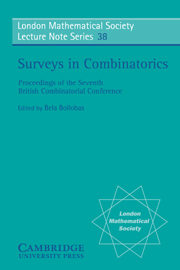Book contents
- Frontmatter
- Contents
- PREFACE
- 1 Resonance and reconstruction
- 2 Symmetry conditions in graphs
- 3 Extremal hypergraph problems
- 4 Connectivity and edge-connectivity in finite graphs
- 5 Partition theory and its applications
- 6 Strongly regular graphs
- 7 Geometries in finite projective and affine spaces
- 8 Long cycles in digraphs with constraints on the degrees
- 9 Colouring problems and matroids
- Index
2 - Symmetry conditions in graphs
Published online by Cambridge University Press: 17 March 2010
- Frontmatter
- Contents
- PREFACE
- 1 Resonance and reconstruction
- 2 Symmetry conditions in graphs
- 3 Extremal hypergraph problems
- 4 Connectivity and edge-connectivity in finite graphs
- 5 Partition theory and its applications
- 6 Strongly regular graphs
- 7 Geometries in finite projective and affine spaces
- 8 Long cycles in digraphs with constraints on the degrees
- 9 Colouring problems and matroids
- Index
Summary
INTRODUCTION
It is only too easy for the proliferation of results involving symmetry conditions in graphs to conform to no very obvious pattern. I should like to try to impose a simple conceptual framework on those sections of the subject in which I have been chiefly involved, by considering a sequence of examples which seem to me to emerge in a natural way. The treatment is by no means either uniform or exhaustive – emphasis and detail reflecting my own personal interests.
All graphs Γ will be finite, undirected, without loops or multiple edges, and are generally assumed to be connected. (Though the ideas usually extend in one way or another to directed graphs, the results and methods of proof rarely do.)
The framework I shall propose arises by first exploring the most extreme symmetry condition one might use to define a class of graphs; afterwards we consider the ways in which such extremism might be most profitably modified.
EXAMPLE I
A graph Γ is (globally) homogeneous if whenever U,V ⊆ VΓ gives rise to isomorphic induced subgraphs <U>,<V>, every isomorphism σ: <U> → <V> extends to an isomorphism of Γ.
Here no restriction is placed on the isomorphism type of the induced subgraphs <U>,<V>, and no assumption is made about the way U and V are embedded in Γ. The assumption is distressingly strong, and one is not surprised to find a complete classification of such graphs.
- Type
- Chapter
- Information
- Surveys in Combinatorics , pp. 22 - 43Publisher: Cambridge University PressPrint publication year: 1979
- 3
- Cited by

